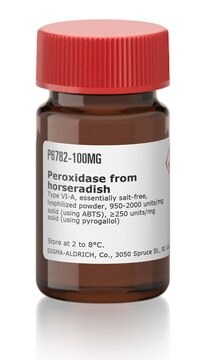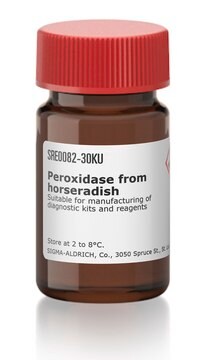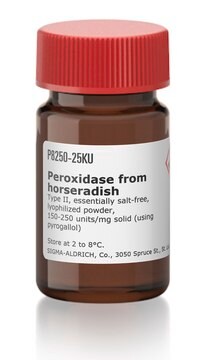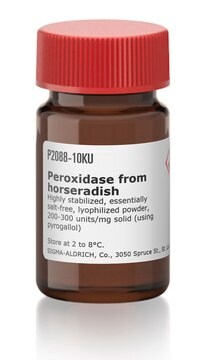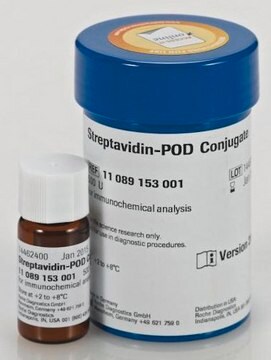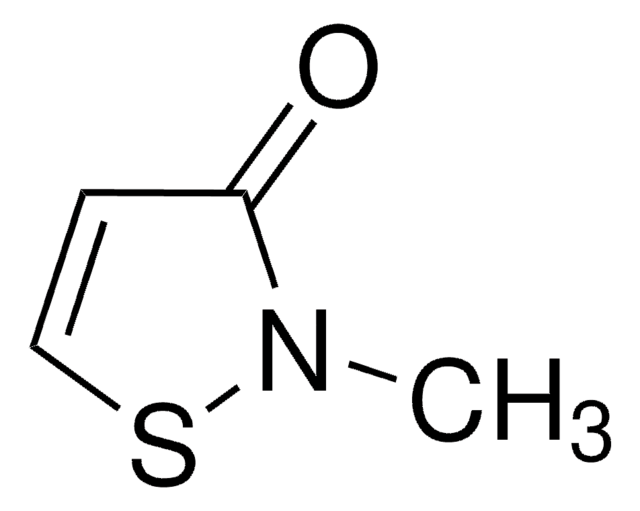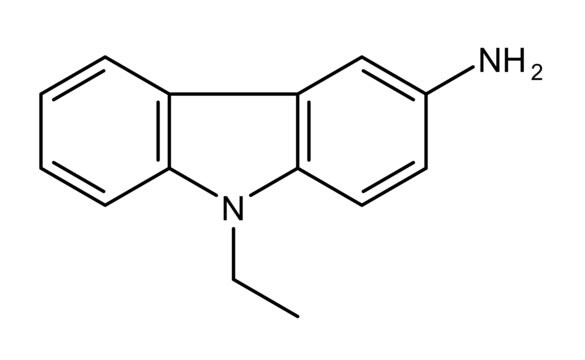추천 제품
사용
sufficient for 5 labeling reactions
Quality Level
특이 활성도
800 U/mg (800 U/mg protein at +25°C and pH 5.0 with ABTS and H2O2 as substrates.)
800 units/mg protein (At 25 °C and pH 5.0 with ABTS and H<sub>2</sub>O<sub>2</sub> as substrates.)
포장
kit of 1 (7 components)
제조업체/상표
Roche
기술
ELISA: suitable
immunoblotting: suitable
immunohistochemistry: suitable
저장 온도
2-8°C
일반 설명
The peroxidase labeling kit is responsible for the labeling of primary amino groups of biomolecules with activated peroxidase (POD) from horseradish.
특이성
Purity number: (A405nm/A275nm): 3.0 – 3.5.
Isoenzyme distribution: > 90% homogeneous isoenzyme C.
Assay Time: The procedure is developed for a reaction temperature of +25°C. At +25°C the reaction time should be 2 hours but it can be extended to 3 hours without influencing the results. Alternatively, the reaction can be carried out at +2 to +8°C with a reaction time of 18 hours up to 24 hours.
Isoenzyme distribution: > 90% homogeneous isoenzyme C.
Assay Time: The procedure is developed for a reaction temperature of +25°C. At +25°C the reaction time should be 2 hours but it can be extended to 3 hours without influencing the results. Alternatively, the reaction can be carried out at +2 to +8°C with a reaction time of 18 hours up to 24 hours.
애플리케이션
The peroxidase labeling kit is designed for labeling water-soluble biomolecules containing reactive and accessible primary amino groups (e.g., peptides or proteins) with peroxidase for use in analytical methods. It is particularly suitable for the coupling of antibodies with peroxidase, as the resulting conjugate is optimal for use in immunochemical detection systems like:
- ELISA (enzyme-linked immunosorbent assay)
- immunohistochemistry
- immunoblotting
특징 및 장점
- Fast - the whole labeling procedure can be performed in one day
- Easy - only 5 simple working steps
- Complete - all necessary buffers and reagents are supplied with the kit
포장
1 kit containing 7 components.
- Peroxidase (activated)
- Sodium Carbonate/hydrogen Carbonate Buffer
- Sodium Borohydride (tablets)
- Triethanolamine Buffer
- Glycine Solution
- Dialysis Buffer
- Stabilizing Agent (includes BSA and Kathon CG)
제조 메모
Working solution: Preparation of working solutions
For best results, mark each solution with the appropriate number. Volumes indicated are sufficient to label a portion of 1.2 mg IgG.
Solution 1: Peroxidase (activated)
Reconstitute the lyophilizate of bottle 1 in 0.5 ml double-distilled water (peroxidase concentration = 16 mg/ml).
Solution 2: Sodium Carbonate/-hydrogencarbo-nate Buffer (100 mM, pH 9.8)
Equilibrate bottle 2 to 15 to 25 °C. Be sure that all buffer components are dissolved. Add 10 ml of bottle 2 to 90 ml double-distilled water, mix well.
Solution 3: Sodium Borohydride Solution (200 mM)
We recommend to wear gloves when working with sodium borohydride. Prepare the solution immediately prior to use and keep cold on ice. Add 1 tablet of bottle 3 to 130 ml cold, double-distilled water, mix well.
Solution 4: Triethanolamine Buffer (2 M, pH 8.0)
Bottle 4, ready-to-use. Equilibrate the bottle to 15 to 25 °C. Be sure that all buffer components are dissolved.
Solution 5: Glycine Solution (1 M, pH 7.0)
Reconstitute the lyophilizate of bottle 5 in 0.5 ml double-dist. water (glycine concentration = 1 M)
Solution 6: Dialysis Buffer (1x conc.)
Equilibrate bottle 6 to 15 to 25 °C. Be sure that all buffer components are dissolved. Add 30 ml of bottle 6 to 570 ml double-dist. water, mix well.
Solution 7: Stabilizing Agent
Bottle 7 is ready-to-use. Equilibrate the bottle to 15 to 25 °C.
Preparation of the immunoglobulin solution
The IgG concentration of the antibody solution should be approx. 4 mg/ml (3.8 to 4.2 mg/ml). This concentration is critical for the coupling and should hence be checked photometrically before every coupling and adjusted if necessary: 1 mg/ml = 1.40 at A280 nm and 1 cm path length. 0.3 ml of this solution are required for each labeling reaction.
Note: Do not use preservatives, such as sodium azide and stabilizers, such as albumin or detergents.
Lyophilized immunoglobulin, salt-free
Weigh 1.6 mg into a suitable vessel and dissolve in 0.4 ml solution 2. Check the concentration and pH and adjust, if necessary.
Immunoglobulin in buffer
Stability of IgG solution
These solutions should always be prepared immediately for use.
Storage conditions (working solution): Stability of solutions
For best results, mark each solution with the appropriate number. Volumes indicated are sufficient to label a portion of 1.2 mg IgG.
Solution 1: Peroxidase (activated)
Reconstitute the lyophilizate of bottle 1 in 0.5 ml double-distilled water (peroxidase concentration = 16 mg/ml).
Solution 2: Sodium Carbonate/-hydrogencarbo-nate Buffer (100 mM, pH 9.8)
Equilibrate bottle 2 to 15 to 25 °C. Be sure that all buffer components are dissolved. Add 10 ml of bottle 2 to 90 ml double-distilled water, mix well.
Solution 3: Sodium Borohydride Solution (200 mM)
We recommend to wear gloves when working with sodium borohydride. Prepare the solution immediately prior to use and keep cold on ice. Add 1 tablet of bottle 3 to 130 ml cold, double-distilled water, mix well.
Solution 4: Triethanolamine Buffer (2 M, pH 8.0)
Bottle 4, ready-to-use. Equilibrate the bottle to 15 to 25 °C. Be sure that all buffer components are dissolved.
Solution 5: Glycine Solution (1 M, pH 7.0)
Reconstitute the lyophilizate of bottle 5 in 0.5 ml double-dist. water (glycine concentration = 1 M)
Solution 6: Dialysis Buffer (1x conc.)
Equilibrate bottle 6 to 15 to 25 °C. Be sure that all buffer components are dissolved. Add 30 ml of bottle 6 to 570 ml double-dist. water, mix well.
Solution 7: Stabilizing Agent
Bottle 7 is ready-to-use. Equilibrate the bottle to 15 to 25 °C.
Preparation of the immunoglobulin solution
The IgG concentration of the antibody solution should be approx. 4 mg/ml (3.8 to 4.2 mg/ml). This concentration is critical for the coupling and should hence be checked photometrically before every coupling and adjusted if necessary: 1 mg/ml = 1.40 at A280 nm and 1 cm path length. 0.3 ml of this solution are required for each labeling reaction.
Note: Do not use preservatives, such as sodium azide and stabilizers, such as albumin or detergents.
Lyophilized immunoglobulin, salt-free
Weigh 1.6 mg into a suitable vessel and dissolve in 0.4 ml solution 2. Check the concentration and pH and adjust, if necessary.
Immunoglobulin in buffer
- When immunoglobulin is dissolved in phosphate buffered saline (PBS) without additional proteins or preservatives: Adjust the pH to 9.8 with 1 M sodium carbonate buffer (bottle 2). If necessary, dilute with solution 2 to obtain an IgG concentration of 4 mg/ml.
- When the immunoglobulin is dissolved in a buffer with organic salts: Dialyse immunoglobulin with solution 2 and adjust the concentration to 4 mg/ml with solution 2.
Stability of IgG solution
These solutions should always be prepared immediately for use.
Storage conditions (working solution): Stability of solutions
- Solution 1 is stable for 3 months at 2 to 8 °C. The solution can be aliquoted and shock-frozen at -60° C or below, and then stored at -15 to -25° C; note that a loss ofactivity of 10 to 20% may be observed.
- Solutions 2, 5 and 6 are stable for one week at 2 to 8 °C, and for 6 months at -15 to -25 °C, when stored frozen in aliquots.
- Solution 3 should always be prepared immediately before use.
- Solution 4 and 7 are stable at 2 to 8 °C until the expiration date indicated on the kit.
기타 정보
For life science research only. Not for use in diagnostic procedures.
키트 구성품 전용
제품 번호
설명
- Peroxidase (activated)
- Sodium Carbonate/Hydrogen Carbonate Buffer
- Sodium Borohydride (tablets)
- Triethanolamine Buffer
- Glycine Solution
- Dialysis Buffer
- Stabilizing Agent (includes BSA and Kathon CG)
신호어
Danger
유해 및 위험 성명서
Hazard Classifications
Acute Tox. 3 - Eye Dam. 1 - Repr. 1B - Resp. Sens. 1 - Skin Corr. 1C - Skin Sens. 1 - Water-react 1 Oral
보충제 위험성
Storage Class Code
4.3 - Hazardous materials which set free flammable gases upon contact with water
WGK
WGK 2
Flash Point (°F)
does not flashNot applicable
Flash Point (°C)
does not flashNot applicable
이미 열람한 고객
Yvonne Naegelin et al.
eNeuro, 5(2) (2018-04-18)
Brain-derived neurotrophic factor (BDNF) secreted by neurons is a significant component of synaptic plasticity. In humans, it is also present in blood platelets where it accumulates following its biosynthesis in megakaryocytes. BDNF levels are thus readily detectable in human serum
Kurt R Brunden et al.
Pharmacological research, 63(4), 341-351 (2010-12-18)
Tau, a protein that is enriched in neurons of the central nervous system (CNS), is thought to play a critical role in the stabilization of microtubules (MTs). Several neurodegenerative disorders referred to as tauopathies, including Alzheimer's disease and certain types
Measuring and Validating the Levels of Brain-Derived Neurotrophic Factor in Human Serum.
Yvonne N, et al.
eNeuro, 5(2), 0419-0419 (2018)
Shiho Miura et al.
Journal of virology, 84(22), 11614-11623 (2010-09-03)
CD1d and CD1d-restricted natural killer T (NKT) cells serve as a natural bridge between innate and adaptive immune responses to microbes. CD1d downregulation is utilized by a variety of microbes to evade immune detection. We demonstrate here that CD1d is
자사의 과학자팀은 생명 과학, 재료 과학, 화학 합성, 크로마토그래피, 분석 및 기타 많은 영역을 포함한 모든 과학 분야에 경험이 있습니다..
고객지원팀으로 연락바랍니다.
